If you are a fan of the hit drama “Squid Game,” I am sure that you already have some knowledge about Korean traditional games. Of course, the games seen on screen were much more…dramatic, for lack of a better word, but they still gave us a look into the games that constitute many Koreans’ childhoods. No matter where you may have grown up, these childhood games are something that many look back on with nostalgia and fondness, and they are something we can look forward to telling future generations about when we reminisce about how we actually had to go outside to get our daily dose of socialization before the internet was a thing.
But the games in “Squid Game” are not the only traditional Korean games that exist. These traditional games, or minsoknori (민속놀이) are diverse and plentiful in genre and are not just a thing of the past. If you watch any Korean variety show, there are many instances of these games being played (usually leading to some unfavorable yet hilarious penalty for the losing individual), showing just how large of a role such games play in Korean culture today.
There are so many games that I can introduce, but I feel that may result in a twenty-page article, so for now I will stick to some of the most infamous games.
Squid (Game) (오징어(놀이))
Starting right off the bat with the game of the same name as the drama. This is a game played between two teams, an offensive team and a defensive team. The rules seem rather complicated, but I will try my best to explain.
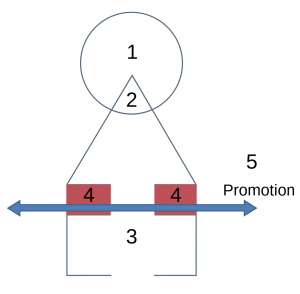
The squid game board
The game gets its name from the squid-like figure that is drawn on the ground made up of a circle, triangle and rectangle. This figure marks the boundaries for the two teams, with the upper circle being the “home” of the offensive team and the lower rectangle belonging to the defensive team. The triangle is neutral ground between the two teams.
The goal for the offensive team is to start at their home and make their way to the defensive team’s home by hopping on one foot around the outside of the game board. Only when they reach one of the designated areas and “promote” (either by making it to area 2 after passing through area 3, or by hopping between the two areas marked “4”) can they use both of their feet to make it back to the offensive house and secure a victory.
Meanwhile, the defensive team’s goal is to block the other team from making it back to their home, done so by pushing the offensive team members out of the game board after they have entered or pushing them into areas into which they are not yet allowed to enter.
A game like squid is definitely something reminiscent of the days before the internet, and reminds me a lot of my own time spent outside during recess in the parking lot behind my elementary school. Back when you did not need lots of fancy technology to have fun with friends, just maybe a piece of chalk and your imagination!
Yutnori (윷놀이)
Yutnori is a type of board game that is often played on the lunar new year (설날). If you’ve ever played the board games Sorry! or Parcheesi, I think you would pick up yutnori rather quickly. The yutnori game board looks like a large square with an ‘x’ running through the middle, with the goal of the game being to move your team’s pieces around the board in one full loop before the other team can.
What distinguishes yutnori from other board games of the same genre is the way in which players determine how many spots they can move their game pieces. Whereas dice and playing cards are often utilized in similar games, the players of yutnori throw up four sticks, each stick having a flat side and a rounded side. The combination of the sticks determines how far the players can move, with there being five combinations possible, each combination having a specific name.

The various combinations one can make with the yut sticks
- do (도) – one stick over (flat side up) and three sticks up (round side up) = advance one space
- gae (개) – two sticks over and two sticks up = advance two spaces
- geol (걸) – three sticks over and one stick up = advance three spaces
- yut (윷) – all sticks over = advance four spaces
- mo (모) – all sticks up = advance five spaces
- *baekdo (백도) – baekdo, which quite literally translates to “back do,” is an additional move that some people choose to play with, where one stick has an ‘x’ marked on the back. If this stick is over and the other three sticks are up, then the players can move one of their pieces back one space, hence the name While baekdo is a mixture of English and Korean, some people also call this move dwido (뒷도), which carries the same meaning but is pure Korean.

baekdo (백도)
When players throw either a yut or a mo, they are able to cast the sticks for another turn, although some people choose not to play with this rule.
The game tokens that players move around the board are called mal (말), and they must move all of their mal around the board and back to the starting point in order to win.They must do their best to avoid the danger of having their mal sent back all the way to the beginning if the opposing team’s token happens to unfortunately land on the same spot as their own. Above all else, yutnori is a game of strategy, with teams often conferring with each other intensely about what path they will lead their mal on to ensure that they return home safely and how they will utilize each of their advancements.

The different paths players follow around the yutnori game board
While the origins of yutnori are still unclear, there is some research that suggests that it was played as early as the period of the Three Kingdoms (57 BC – 668 AD). Now it is one of the most well-known traditional games in the Republic of Korea and is played in every region of the country, with different regions adding unique and fun rules of their own to continue the evolution of yutnori.
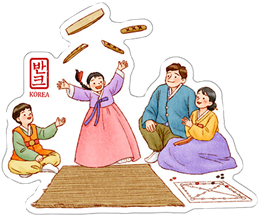
Tuho (투호)
Compared to squid and yutnori, tuho is a much more straightforward and simple game. Tuho is a game often played in the front yard or main floor of the house, where two teams compete in trying to throw arrows into pots that are placed some distance away. The length of the arrows, the shape of the pots, and the distance from the pot each team must stand varies greatly by person and household, but the overall goal of the game remains the same regardless of location.
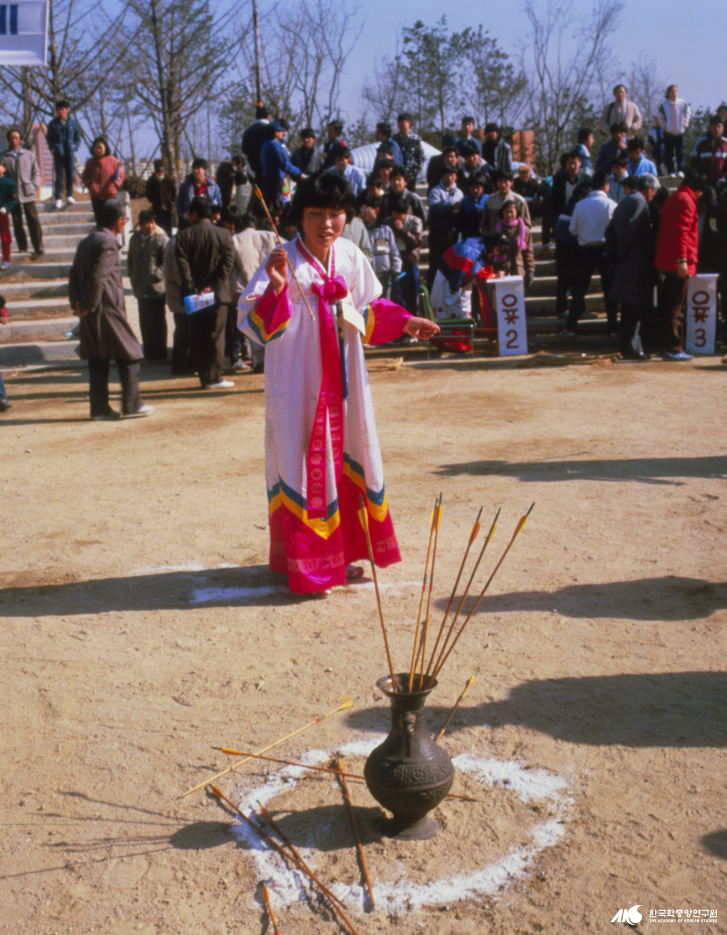
Tuho (투호)
Tuho is a game that originated in China during the Han Dynasty (202 BC – 220 AD) that eventually made its way to Korea during the Three Kingdoms era, with many recordings of the game being played especially in Goguryeo (고구려) and Baekje (백제).
At the beginning of the Goryeo Dynasty (고려시대; 918 – 1392), tuho was not played until King Yejong (고려 예종) began to advertise the game to officials. His encouragement depicted tuho as a tool that could be used to master proper edicate and manners within the royal family, and later, during the Joseon Dynasty (1392 – 1910), had its status elevated as people began to recognize it as a means to master the etiquette taught in Confucianism. From then on, tuho was not only restricted to the royal family, but also began to be played by yangban (양반) or the social elite of Korean society at the time.
Of course, tuho has come a long way since then, and is now a game that can be played by anyone and everyone. It is another game that is often played on the lunar new year or chuseok (추석).
There are also many traditional games that are not just limited to Korea and can be seen all around the world, with many countries having adopted their own versions of games that utilize similar rules and principles.
For example, Korea’s gonginori (공기놀이) is similar to the game of jacks, where players must toss a small stone into the air and catch it while also trying to pick up other stones off the ground at the same time.
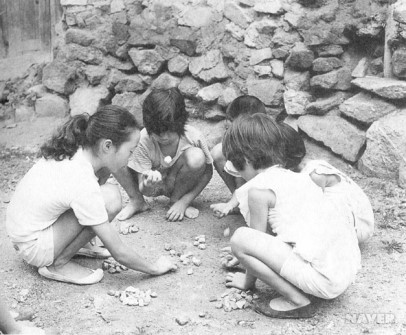
Children playing gonginori together outside
Jegichagi (제기차기) is much like the game of hacky sack, where players compete to see who can keep the jegi, or hacky sack, in the air the longest using only their feet to kick it repeatedly.
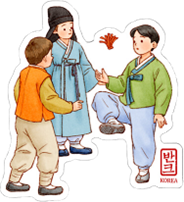
Jegichagi (제기차기)
However, while a hacky sack is often a small ball made of yarn and filled with plastic beans, the jegi was traditionally made from a coin with a hole drilled through the middle that then had paper weaved through its center. Nowadays, jegi are often made with a weighted plastic bottom and colorful streamers.
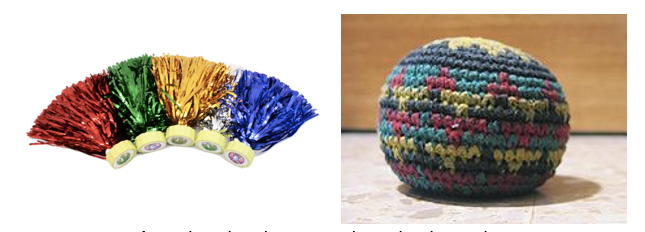
A modern jaegi compared to a hacky sack
Additionally, tug-of-war, or juldarigi (줄다리기) in Korean, is a traditional game that can still be found on the playgrounds of elementary schools today.
While there are certainly all types of unique games that play a large role in Korean culture, there are also many games that can be found not just on the Korean peninsula but all around the world as well, carrying the message that, while we may be distant geographically and may not speak the same language, there are many shared experiences that exist between us and connect us in ways that we may not have been able to imagine.
Written by : Allison Garbacz
From Illinois, United States. Current 5th-year undergraduate at the University of Wisconsin-Madison, B.A. Candidate for Linguistics, B.A. Candidate for Asian Languages and Cultural Studies, Exchange student at Korea University, Intern at VANK (Voluntary Agency Network of Korea)